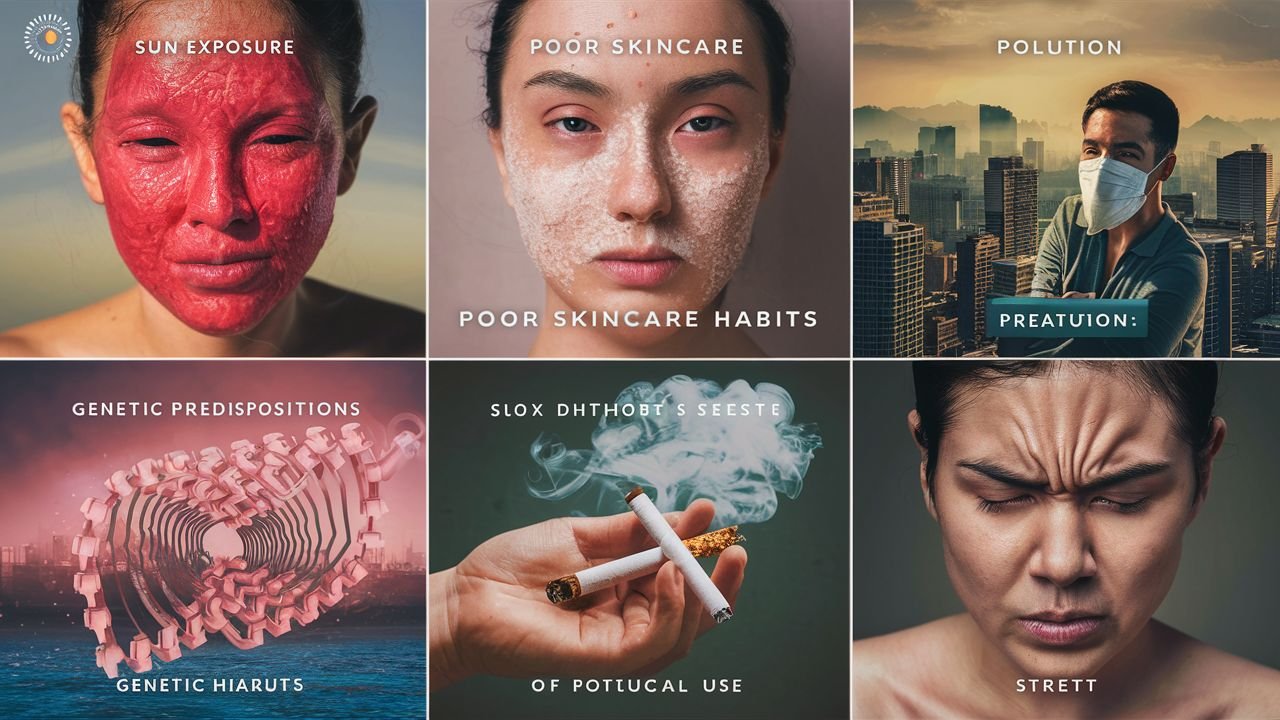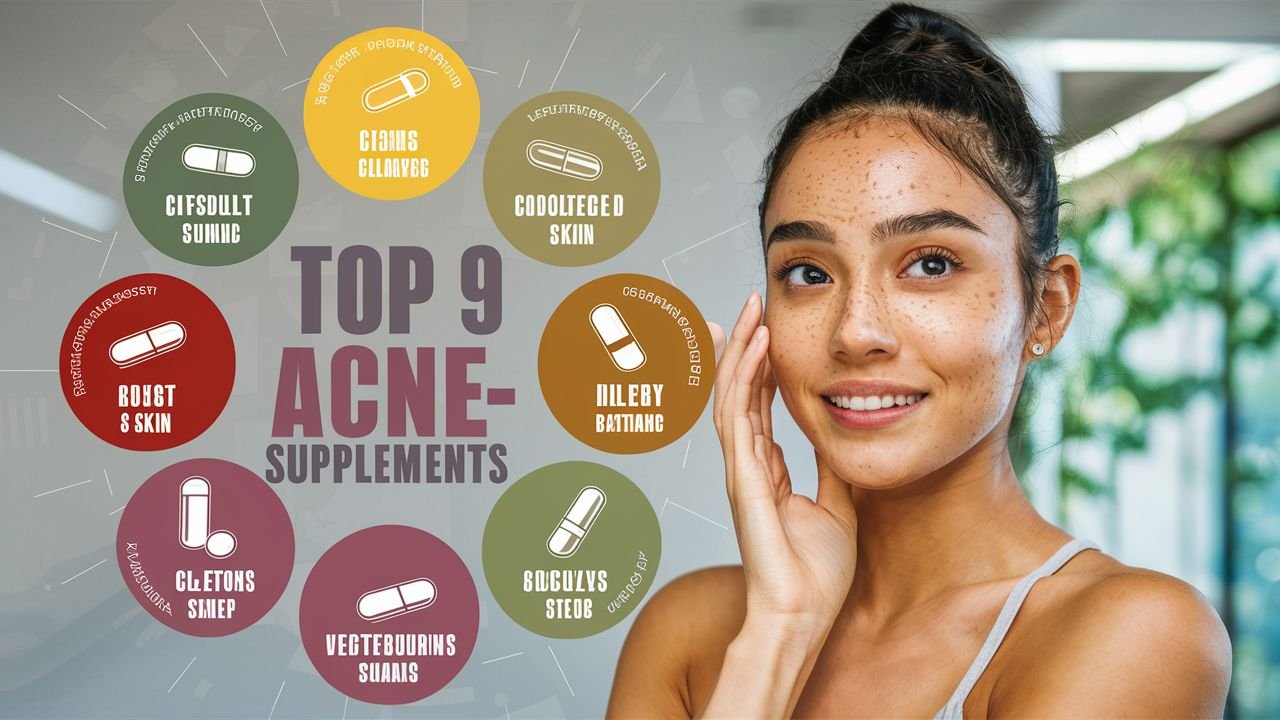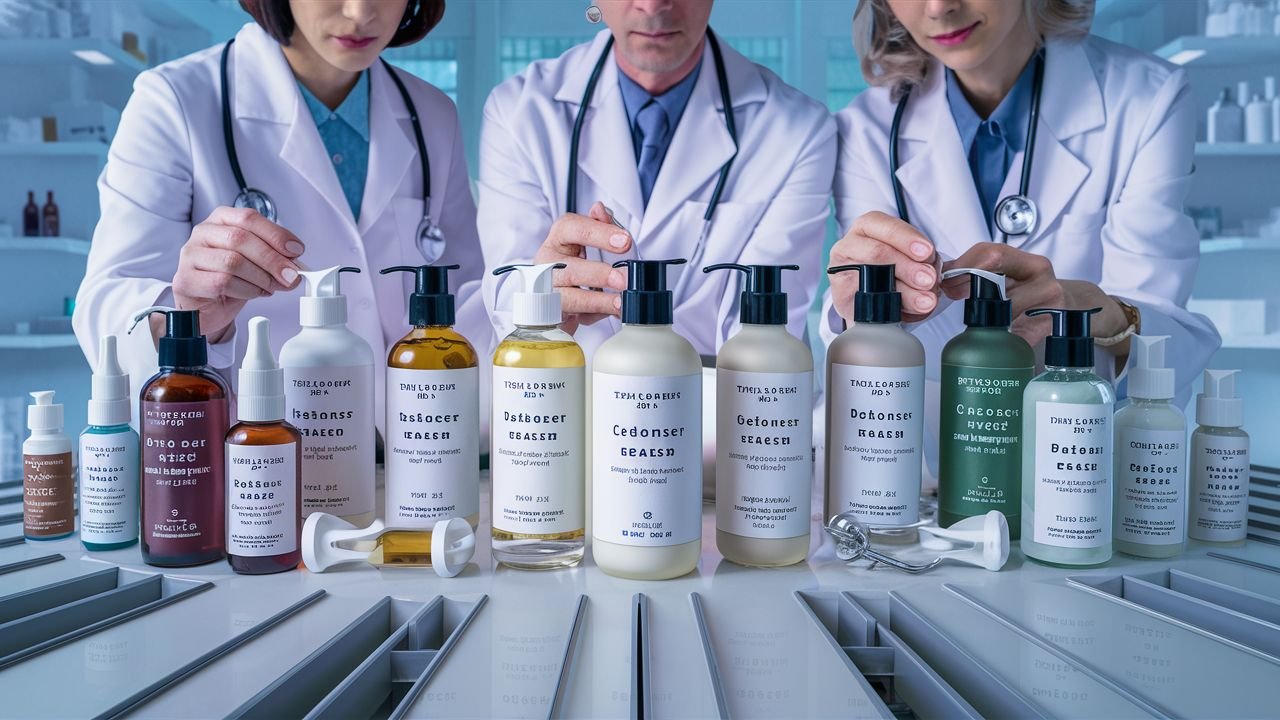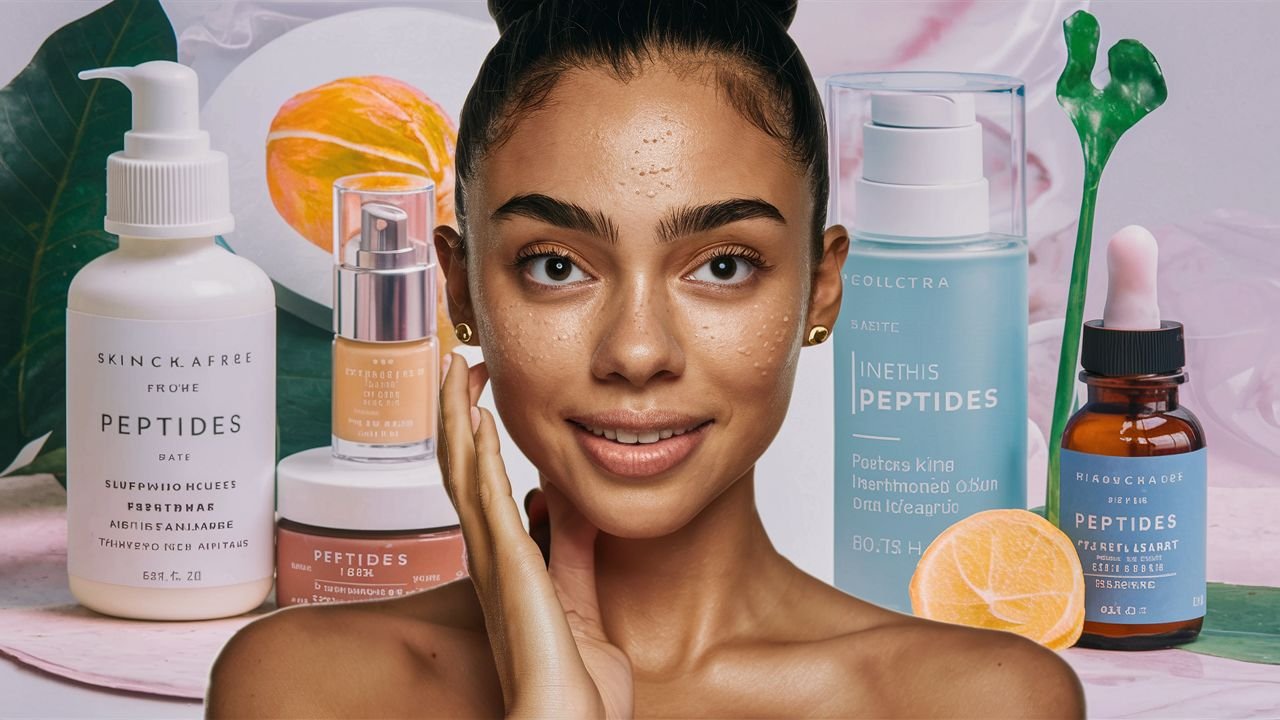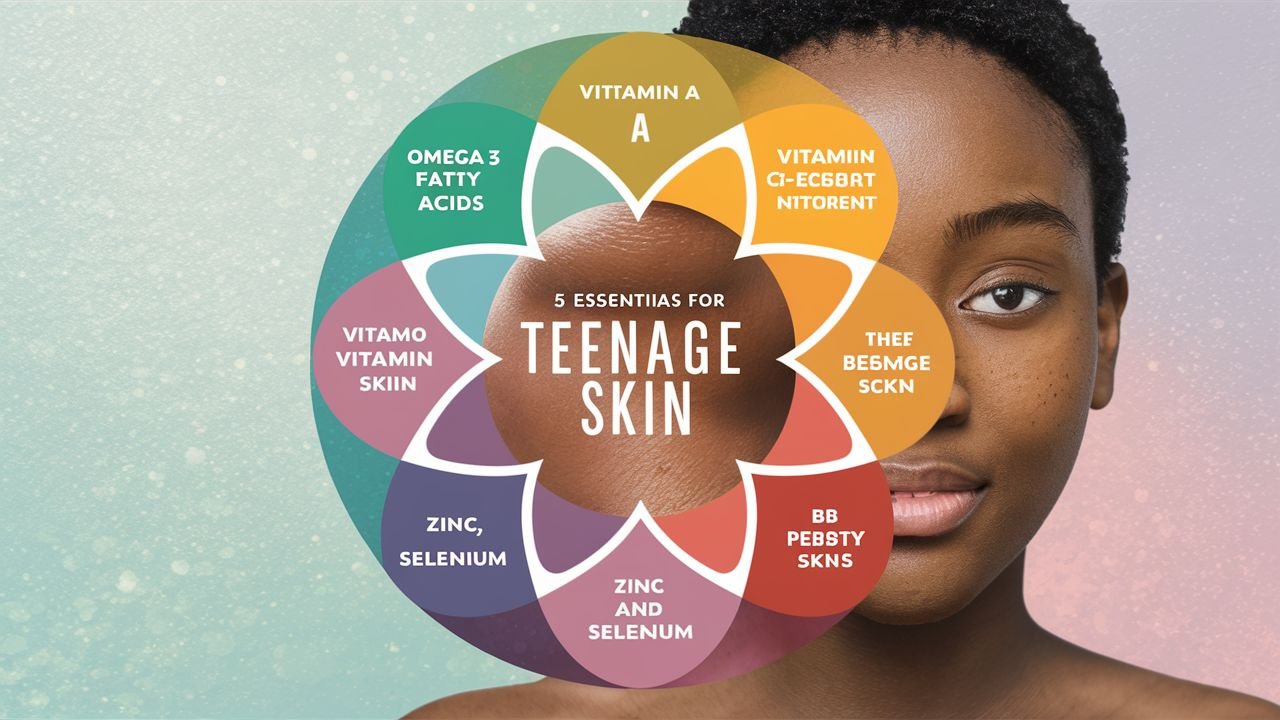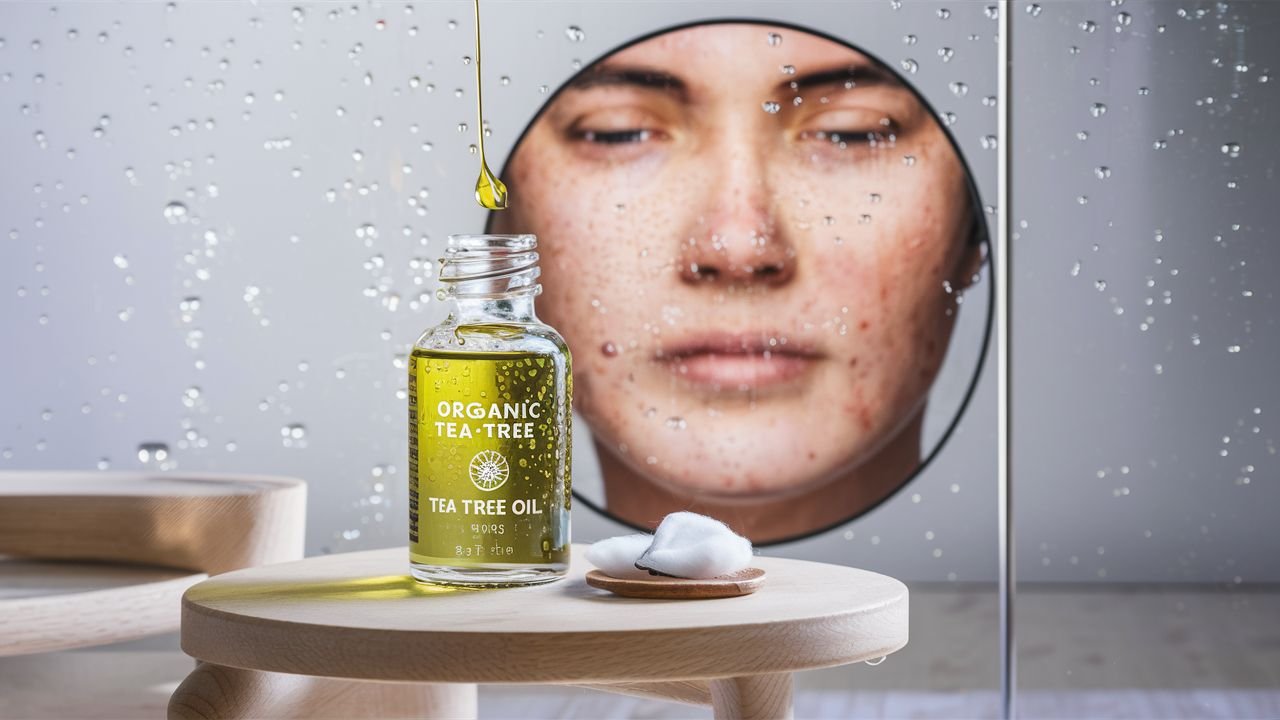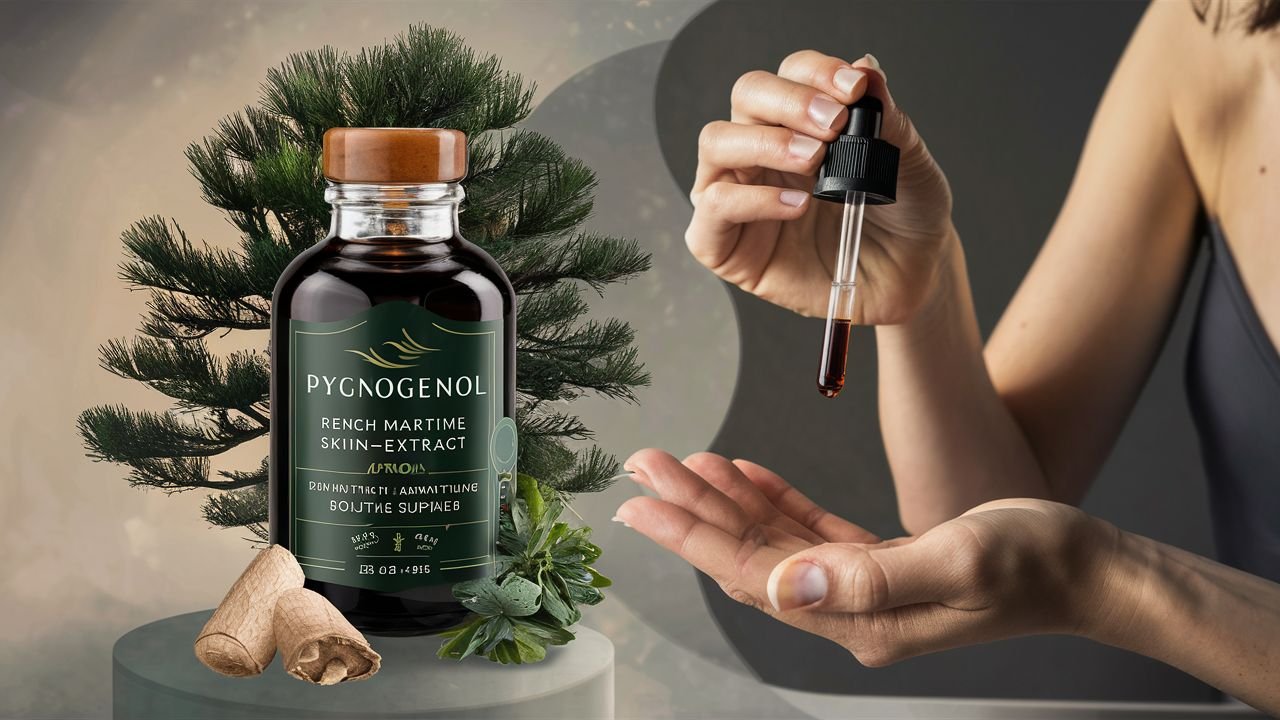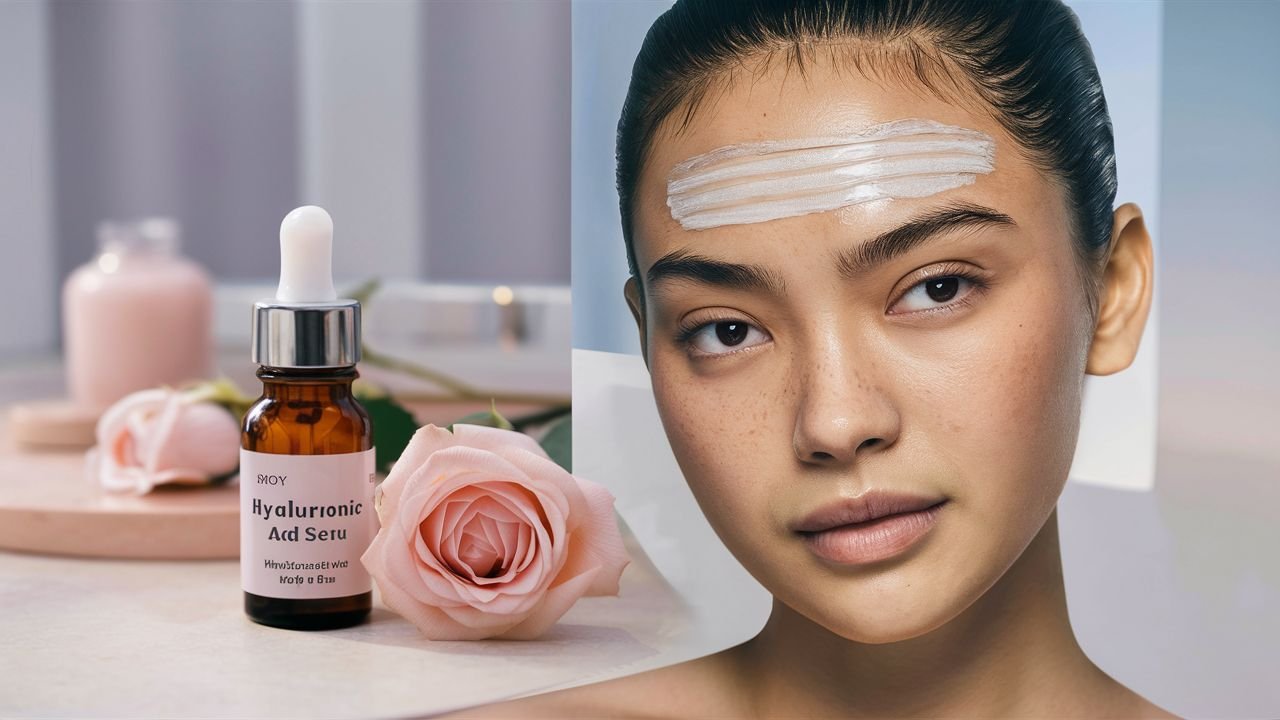Heal and Conceal Rosacea: Effective Skincare Tips
Do you struggle with rosacea and wish for clear, calm skin? Are you searching for effective ways to treat and conceal the redness and inflammation associated with this condition? Look no further. In this article, we will reveal powerful skincare tips that can help you both heal and conceal rosacea, allowing you to regain confidence and enjoy smoother, more radiant skin.
Key Takeaways:
- Discover effective skincare tips for managing and healing rosacea.
- Learn how to conceal redness and inflammation with a targeted skincare routine.
- Explore various treatment options for rosacea, including topical creams and laser therapy.
- Find expert techniques for concealing rosacea with makeup.
- Explore natural remedies and lifestyle changes that can contribute to healing rosacea.
Understanding Rosacea: Causes, Symptoms, and Triggers
Before diving into the healing and concealing methods, it’s important to understand the causes, symptoms, and triggers of rosacea. By gaining insight into these fundamental aspects of the condition, individuals can better manage and control their symptoms.
Causes of Rosacea
Rosacea is a chronic skin condition that can be influenced by various factors. While the exact cause is still unknown, researchers believe that a combination of genetic and environmental factors play a role in its development.
Some potential causes of rosacea include:
- Genetics: A family history of rosacea may increase the chances of developing the condition.
- Dysfunction of the blood vessels: Abnormalities in blood vessels may contribute to facial redness and flushing.
- Inflammatory response: Inflammation in the skin can trigger rosacea symptoms.
- Demodex mites: These microscopic organisms that naturally inhabit the skin may contribute to rosacea development in some individuals.
Symptoms of Rosacea
Rosacea is characterized by a range of symptoms that can vary in severity from person to person. The most common symptoms include:
- Facial redness: Persistent redness and flushing are hallmark signs of rosacea.
- Bumps and pimples: Small, inflamed bumps resembling acne breakouts may appear on the face.
- Visible blood vessels: Thin, visible blood vessels may become more prominent on the face.
- Sensitive skin: Rosacea-prone skin tends to be more sensitive and easily irritated.
- Burning or stinging sensations: Some individuals with rosacea may experience burning or stinging sensations on the affected skin.
Triggers of Rosacea
Identifying and avoiding triggers can help individuals manage and reduce flare-ups of rosacea. While triggers can vary from person to person, some common factors include:
- Exposure to sunlight: Sun exposure can exacerbate rosacea symptoms due to increased heat and UV radiation.
- Hot drinks and spicy foods: Consuming hot beverages or spicy foods can trigger facial flushing and redness.
- Alcohol and caffeine: Alcohol and caffeine are known to dilate blood vessels, leading to increased redness and flushing.
- Stress: Emotional stress and anxiety can trigger rosacea flare-ups in some individuals.
- Extreme temperatures: Exposing the skin to extreme heat or cold weather conditions may aggravate rosacea symptoms.
“Identifying and avoiding triggers is an essential part of managing rosacea symptoms and minimizing flare-ups.”
Understanding the causes, symptoms, and triggers of rosacea is crucial for effective management and control of this chronic condition. By recognizing the underlying factors and adopting strategies to avoid triggers, individuals can take proactive steps towards improving their skin health.
| Causes | Symptoms | Triggers |
|---|---|---|
| Genetics | Facial redness | Exposure to sunlight |
| Dysfunction of the blood vessels | Bumps and pimples | Hot drinks and spicy foods |
| Inflammatory response | Visible blood vessels | Alcohol and caffeine |
| Demodex mites | Sensitive skin | Stress |
| Burning or stinging sensations | Extreme temperatures |
Developing a Rosacea-Friendly Skincare Routine
When it comes to managing and healing rosacea, establishing a proper skincare routine is essential. By following a targeted regimen, you can effectively minimize symptoms and promote healthy skin. Here, we provide step-by-step guidance on developing a rosacea-friendly skincare routine that prioritizes gentle, soothing products.
Gentle Cleansing and Soothing
To kickstart your skincare routine, start with a gentle cleanser that won’t strip your skin of its natural oils or exacerbate rosacea symptoms. Look for cleansers labeled specifically for sensitive or rosacea-prone skin. Consider products with the following key ingredients:
- Oatmeal extract: Soothes inflammation and reduces redness
- Chamomile: Calms and restores skin’s natural balance
- Aloe Vera: Provides cooling relief and hydration
Cleanse your face twice a day, using lukewarm water and your fingertips to gently massage the cleanser onto your skin. Avoid scrubbing or using harsh exfoliants, as these can aggravate rosacea.
Moisturize and Hydrate
After cleansing, it’s crucial to replenish your skin’s moisture barrier with a gentle, hydrating moisturizer. Look for products that are labeled as non-comedogenic, fragrance-free, and suitable for sensitive skin.
When selecting a moisturizer, opt for one that contains the following beneficial ingredients:
- Hyaluronic acid: Retains moisture and plumps the skin
- Niacinamide: Strengthens the skin barrier and reduces redness
- Ceramides: Helps repair and protect the skin
Apply your moisturizer to clean, dry skin in gentle, upward motions. Allow the product to fully absorb before moving on to the next step in your routine.
Sun Protection Is Key
Protecting your skin from harmful UV rays is crucial for managing rosacea. Sun exposure can worsen symptoms and trigger flare-ups. Incorporating a broad-spectrum SPF into your skincare routine can help shield your skin from damaging rays.
Look for sunscreens specifically formulated for sensitive or rosacea-prone skin. Look for these important factors:
- SPF 30 or higher: Provides optimal sun protection
- Physical or mineral sunscreen: Contains ingredients like zinc oxide or titanium dioxide that sit on top of the skin and reflect UV rays
- Fragrance-free and non-irritating: Minimizes the risk of dermatitis or rosacea flare-ups
Apply sunscreen generously to all exposed areas of your face and neck every morning, even on cloudy days.
Now that you have the basic steps for a rosacea-friendly skincare routine, make sure to avoid any products that may trigger rosacea symptoms. Common ingredients to avoid include alcohol, fragrances, menthol, and harsh exfoliants.
Remember to always patch test new products and consult with a dermatologist if you have any concerns about product compatibility with your rosacea-prone skin. Building a routine that prioritizes gentleness and soothing ingredients will help you effectively manage rosacea and promote overall skin health.
| Product Type | Recommended Brands |
|---|---|
| Gentle Cleansers | Dermalogica UltraCalming Cleanser, Cetaphil Gentle Skin Cleanser, La Roche-Posay Toleriane Hydrating Gentle Cleanser |
| Moisturizers | Murad Redness Therapy CalmPlex, Aveeno Ultra-Calming Daily Moisturizer, Eucerin Redness Relief Night Cream |
| Sunscreens | EltaMD UV Clear Facial Sunscreen, La Roche-Posay Anthelios Melt-in Sunscreen Milk, Neutrogena Sensitive Skin Face Liquid Sunscreen |
Effective Rosacea Treatment Options
When it comes to healing rosacea, there are various treatment options available to effectively manage symptoms and promote skin health. From topical creams and oral medications to laser therapy and natural remedies, each treatment method has its own set of pros and cons that should be considered.
1. Topical Creams: Topical creams are a commonly prescribed treatment for rosacea. These creams usually contain ingredients like metronidazole, azelaic acid, or ivermectin, which help to reduce redness and inflammation. Applying the cream directly to the affected areas can provide relief and improve the overall appearance of the skin.
2. Oral Medications: In some cases, oral medications may be prescribed to manage rosacea symptoms. Antibiotics like doxycycline or tetracycline can help reduce inflammation and control the growth of bacteria associated with rosacea. However, it’s important to note that long-term use of oral antibiotics should be done under the guidance of a healthcare professional.
3. Laser Therapy: Laser therapy is a non-invasive treatment option that can effectively target and reduce visible blood vessels and redness associated with rosacea. This treatment uses intense pulsed light (IPL) or laser devices to deliver controlled energy to the affected areas, promoting skin healing and reducing the appearance of rosacea symptoms.
4. Natural Remedies: Many individuals with rosacea find relief by incorporating natural remedies into their skincare routine. These remedies can include ingredients like green tea extracts, aloe vera gel, chamomile, or tea tree oil, which have anti-inflammatory and soothing properties. While natural remedies may not work for everyone, they can be a gentle and complementary addition to a comprehensive treatment plan.
It’s important to note that the effectiveness of each treatment option can vary depending on the individual’s specific condition and needs. Consulting with a dermatologist or healthcare professional is crucial for proper diagnosis and personalized treatment recommendations.
Concealing Rosacea with Makeup: Tips and Techniques
When it comes to managing rosacea, makeup can be a game-changer. With the right techniques and products, you can effectively cover up redness and inflammation, boosting your confidence and achieving a natural-looking complexion. Here, we discuss expert tips and tricks for concealing rosacea with makeup, along with some of the best products specifically designed for rosacea-prone skin.
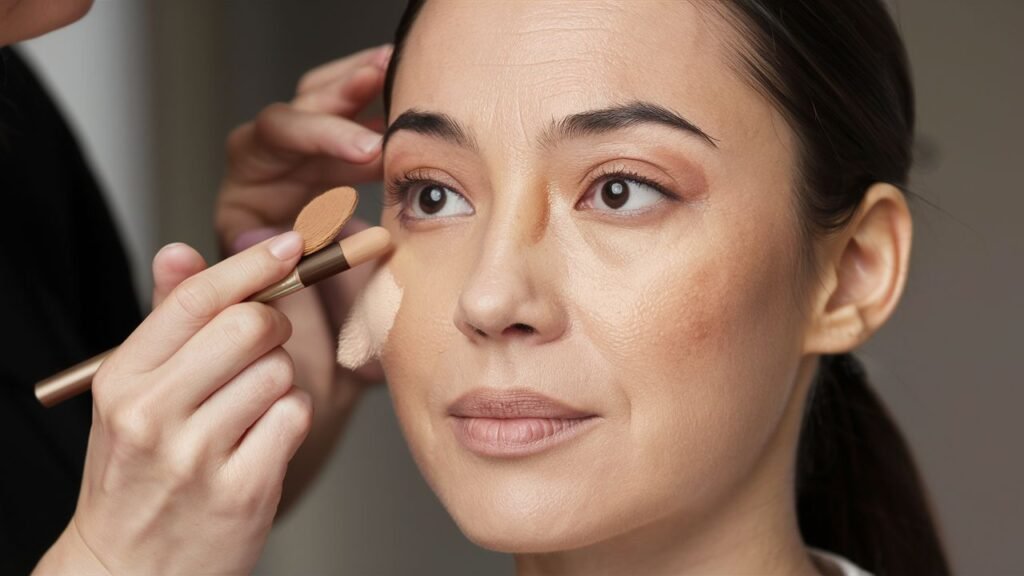
Choosing the Best Makeup for Rosacea
When selecting makeup products for rosacea, it’s important to opt for formulas that are gentle and non-irritating, as well as those that provide coverage without clogging pores. Look for products that are specifically designed for sensitive and reactive skin, as they often contain calming ingredients to soothe inflammation. Mineral-based foundations and tinted moisturizers with light to medium coverage can work well for camouflaging rosacea while allowing your skin to breathe.
Application Techniques for a Flawless Finish
Now that you have the right makeup products, it’s time to master the application techniques that will give you a flawless finish. Here are some expert tips to follow:
- Start with clean, moisturized skin: Properly cleanse and moisturize your skin before applying makeup to create a smooth canvas for even application.
- Use color correcting techniques: Consider using color correcting products to neutralize the redness. For example, a green-toned primer or concealer can help cancel out the redness before applying foundation.
- Build coverage gradually: Instead of applying a heavy layer of foundation all at once, start with a light layer and build up coverage where needed. This approach will help you achieve a more natural-looking finish.
- Blend, blend, blend: Take the time to blend your foundation and concealer well into the skin for a seamless look. Using a damp makeup sponge or a dense, synthetic brush can help achieve a smooth and flawlessly blended result.
- Set your makeup: To ensure your makeup lasts throughout the day and stays in place, set it with a translucent or mineral powder. This can help control excess oil and reduce shine without emphasizing dryness or texture.
Expert Tips for Natural-Looking Makeup
While covering up rosacea is the main goal, achieving a natural-looking makeup finish is equally important. Here are a few expert tips to help your makeup look effortlessly natural:
- Avoid heavy powders and matte finishes, as they can make the skin appear dull and emphasize texture. Opt for satin or dewy finish foundations that give a healthy glow.
- Keep the rest of your makeup minimal. Rosacea-prone skin can be sensitive, so opt for neutral shades and steer clear of harsh or highly pigmented colors that may further irritate the skin.
- Consider using cream or liquid blushes instead of powder blushes for a more natural-looking flush. These formulations blend seamlessly with foundation and give a radiant finish.
- Don’t forget to enhance your eyes and lips. Playing up other features of your face can draw attention away from the areas affected by rosacea and create a balanced, polished look.
With these expert tips and techniques, you can confidently conceal your rosacea and achieve a natural-looking complexion. Remember, everyone’s skin is unique, so don’t be afraid to experiment and find the approach that works best for you.
Healing Rosacea Naturally: Lifestyle and Diet Recommendations
In addition to skincare and treatment options, adopting a balanced lifestyle and following a rosacea-friendly diet can help heal rosacea naturally from within. Certain foods and beverages can aggravate rosacea symptoms, while others can help manage inflammation and improve overall skin health.
It is important to note that dietary changes should always be discussed with a healthcare professional, especially if you have any underlying health conditions or are taking medications.
Foods and Beverages to Avoid
Avoiding trigger foods can help reduce flare-ups and manage rosacea symptoms. Some common foods and beverages that may worsen rosacea include:
- Spicy foods: Spices such as chili peppers, cayenne pepper, and paprika can increase blood flow and lead to flushing.
- Alcohol: Alcohol dilates blood vessels and can trigger flushing and inflammation.
- Hot beverages: Hot drinks like coffee and tea can cause flushing.
- Processed and high-sugar foods: Processed foods and those high in sugar can contribute to inflammation.
Rosacea-Friendly Diet Recommendations
Avoiding trigger foods is only part of the equation. Incorporating foods that promote skin health and reduce inflammation can also be beneficial. Consider the following recommendations:
- Anti-inflammatory foods: Incorporate foods rich in omega-3 fatty acids, such as fatty fish (salmon, mackerel), walnuts, and flaxseeds. These foods can help reduce inflammation in the body.
- Leafy greens: Include plenty of leafy green vegetables like spinach, kale, and Swiss chard. These vegetables are packed with antioxidants that support skin health.
- Colorful fruits: Opt for fruits like berries, oranges, and melons that are high in antioxidants and vitamins.
- Probiotics: Consider adding probiotic-rich foods like yogurt and fermented vegetables to promote gut health, which can indirectly benefit the skin.
Consult with a healthcare professional or a registered dietitian for personalized dietary advice tailored to your individual needs and health condition.
Herbal and Home Remedies for Rosacea Relief
For individuals seeking natural alternatives to manage their rosacea symptoms, herbal and home remedies can provide effective relief. These remedies harness the power of natural ingredients to soothe redness, inflammation, and sensitivity associated with rosacea. Below are some tried and tested remedies that you can try at home:

Soothing Herbal Remedies:
Herbal remedies have long been used for their anti-inflammatory and calming properties. Here are a few herbs that may help alleviate rosacea symptoms:
- Chamomile: Chamomile is known for its soothing properties and can help reduce redness and irritation. You can make a chamomile tea and use it as a facial compress or incorporate it into homemade face masks.
- Licorice root: Licorice root has anti-inflammatory properties that can help reduce rosacea-related inflammation. Look for skincare products that contain licorice extract or prepare a licorice root-infused face wash or toner.
- Green tea: Green tea contains antioxidants that can help calm inflammation. Apply cooled green tea bags to your skin as a soothing compress or use green tea extract in DIY facial masks.
DIY Face Masks:
Homemade face masks can be a cost-effective and natural way to manage rosacea symptoms. These masks can help soothe the skin, reduce redness, and provide relief from inflammation. Here are a few simple DIY face mask recipes:
- Cucumber and Aloe Vera mask: Puree cucumber and mix it with aloe vera gel to create a cooling and hydrating mask. Apply the mixture to your face and leave it on for 15-20 minutes before rinsing off with cool water.
- Oatmeal and Honey mask: Mix oatmeal with honey to create a mask that can help calm inflammation and moisturize the skin. Apply the paste to your face and leave it on for 15 minutes before rinsing off with warm water.
These DIY face masks should only be applied to clean skin and used in moderation. If you experience any irritation or discomfort, discontinue use and consult a dermatologist.
Topical Treatments:
Aside from herbal remedies and DIY face masks, there are several natural topical treatments that can provide relief from rosacea symptoms. Consider incorporating the following ingredients into your skincare routine:
- Lavender oil: Lavender oil has anti-inflammatory and soothing properties. Dilute a few drops of lavender oil with a carrier oil, such as jojoba or coconut oil, and apply it to affected areas.
- Manuka honey: Manuka honey has antibacterial properties that can help calm inflammation and promote healing. Apply a thin layer of manuka honey to clean skin and leave it on for 10-15 minutes before rinsing off.
Keep in mind that while these herbal and home remedies may provide relief for some individuals, they may not work for everyone. It is always important to consult with a dermatologist before trying any new treatment or remedy to ensure it is safe and suitable for your specific condition.
Understanding Rosacea Triggers and How to Avoid Them
Identifying and avoiding rosacea triggers is crucial for preventing flare-ups and effectively managing this condition. By understanding the common triggers, individuals can implement practical strategies to minimize exposure and reduce the frequency and intensity of rosacea flare-ups.
Sunlight
Exposure to sunlight is a known trigger for rosacea flare-ups. The ultraviolet (UV) rays can cause inflammation and aggravate the skin, leading to redness and increased sensitivity. It’s essential to protect your skin from the sun by wearing broad-spectrum sunscreen with a high SPF, seeking shade whenever possible, and wearing protective clothing like hats and sunglasses.
Alcohol
Alcohol consumption is another common trigger for rosacea. It can dilate blood vessels and increase facial redness and flushing. To manage your condition, it’s advisable to limit or avoid alcohol consumption, especially drinks with high alcohol content such as spirits. Instead, opt for non-alcoholic alternatives like mocktails or infused water.
Spicy Foods
Spicy foods, such as hot peppers and certain spices, can trigger rosacea flare-ups in some individuals. These foods can cause blood vessels to dilate and lead to increased facial redness and flushing. It’s recommended to identify and avoid specific spicy foods that trigger your symptoms to help minimize flare-ups.
Stress
Stress is often associated with rosacea flare-ups. Emotional stress can lead to the release of stress hormones that dilate blood vessels and contribute to increased redness and inflammation. Finding effective stress management techniques such as exercise, meditation, or therapy can help reduce the impact of stress on your rosacea symptoms.
Other Triggers
While sunlight, alcohol, spicy foods, and stress are commonly reported triggers, it’s important to note that triggers can vary from person to person. Some individuals may have additional triggers, such as certain skincare products, extreme temperatures, or even specific medications. It’s crucial to pay attention to your own triggers and make note of any patterns or associations.
By identifying and avoiding these triggers, individuals with rosacea can significantly reduce the occurrence of flare-ups and better manage their condition. It’s important to remember that rosacea triggers can be unique to each individual, so it’s essential to listen to your skin and make adjustments accordingly.
The Role of Stress Management in Rosacea Care
Stress has been known to have a significant impact on individuals with rosacea, often exacerbating their symptoms. Understanding the link between stress and rosacea is crucial for effective management and care. Incorporating stress management techniques into your daily routine can help alleviate symptoms and improve overall well-being. Additionally, seeking support from rosacea-specific online communities and support networks can provide valuable guidance and a sense of community.
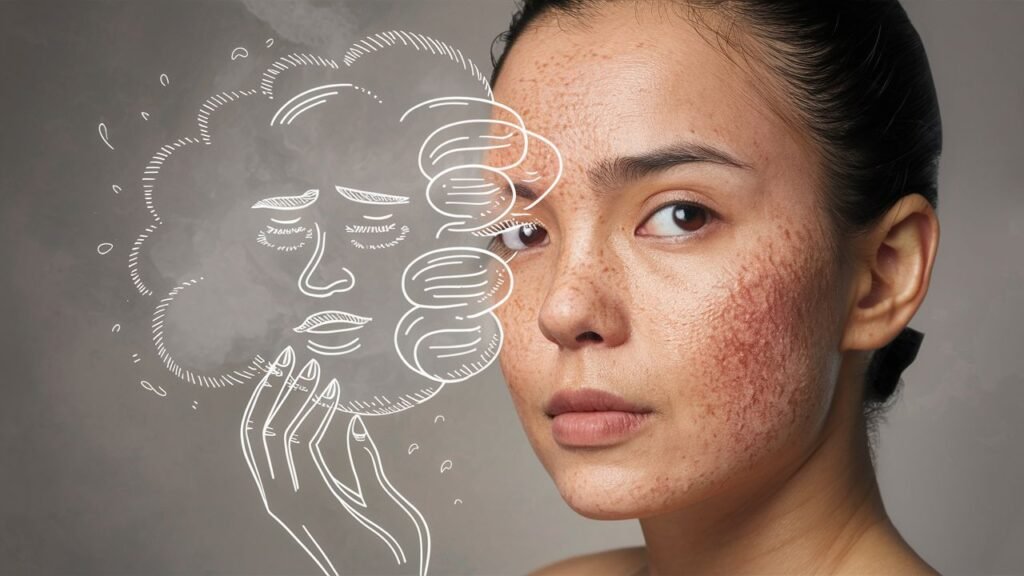
Exploring the Link Between Stress and Rosacea
A growing body of research suggests that stress can trigger or worsen rosacea symptoms. When the body is under stress, it releases certain hormones that can affect the immune system and blood vessels, leading to inflammation and increased blood flow to the skin. This, in turn, can result in rosacea flare-ups characterized by redness, swelling, and sensitivity.
“When the body is under stress, it releases certain hormones that can affect the immune system and blood vessels, leading to inflammation and increased blood flow to the skin.”
To effectively manage rosacea, it’s important to address stress levels and adopt stress management techniques as part of your self-care routine. By minimizing stress, individuals may experience a reduction in the frequency and intensity of rosacea flare-ups.
Effective Stress Management Techniques
There are various stress management techniques that can help individuals with rosacea find relief and improve their overall well-being. Some effective techniques to consider include:
- Practicing relaxation techniques such as deep breathing exercises, meditation, or yoga.
- Engaging in regular physical activity, as exercise has been shown to reduce stress levels.
- Prioritizing self-care activities that promote relaxation, such as taking warm baths, practicing mindfulness, or enjoying a hobby.
- Ensuring an adequate amount of sleep each night, as lack of sleep can increase stress levels.
- Seeking professional help from therapists or counselors who specialize in stress management.
Support from Rosacea-Specific Communities and Support Networks
Connecting with others who are also navigating life with rosacea can provide a sense of understanding, support, and valuable insights. Online communities and support networks dedicated to rosacea offer a platform to share experiences, seek advice, and gain encouragement from individuals facing similar challenges.
Interacting with others in these communities can provide a sense of belonging, reduce isolation, and create opportunities to exchange tips and resources. It’s important to note that these communities should not replace medical advice or professional treatment, but rather serve as a source of support and camaraderie.
| Benefits of Seeking Support from Rosacea Communities | Online Resources |
|---|---|
| 1. Emotional support: Connect with individuals who understand the challenges of living with rosacea. | Rosacea Support Community Forum – www.rosacea-support.org |
| 2. Exchanging tips and advice: Share and learn practical strategies to manage symptoms. | Rosacea Group Support Forum – www.rosaceagroup.org |
| 3. Product recommendations: Discover rosacea-friendly products recommended by other community members. | National Rosacea Society – www.rosacea.org |
| 4. Empowerment: Gain confidence and motivation through shared experiences and success stories. | Rosacea Facebook Support Groups – search “rosacea support” on Facebook |
Remember, everyone’s experience with rosacea is unique, and what works for one person may not work for another. It’s important to consult with a healthcare professional for personalized advice and treatment options.
Recognizing and Treating Rosacea Subtypes
Rosacea is a chronic skin condition that can manifest in different subtypes, each presenting with its unique set of symptoms and characteristics. Understanding the specific subtype of rosacea that an individual has is crucial for effective treatment and management of the condition. In this section, we will explore the various subtypes of rosacea, their distinguishing features, and the targeted treatments and specific medications that are often prescribed based on the subtype. By recognizing and addressing the specific subtype of rosacea, individuals can experience improved symptom relief and better overall skin health.
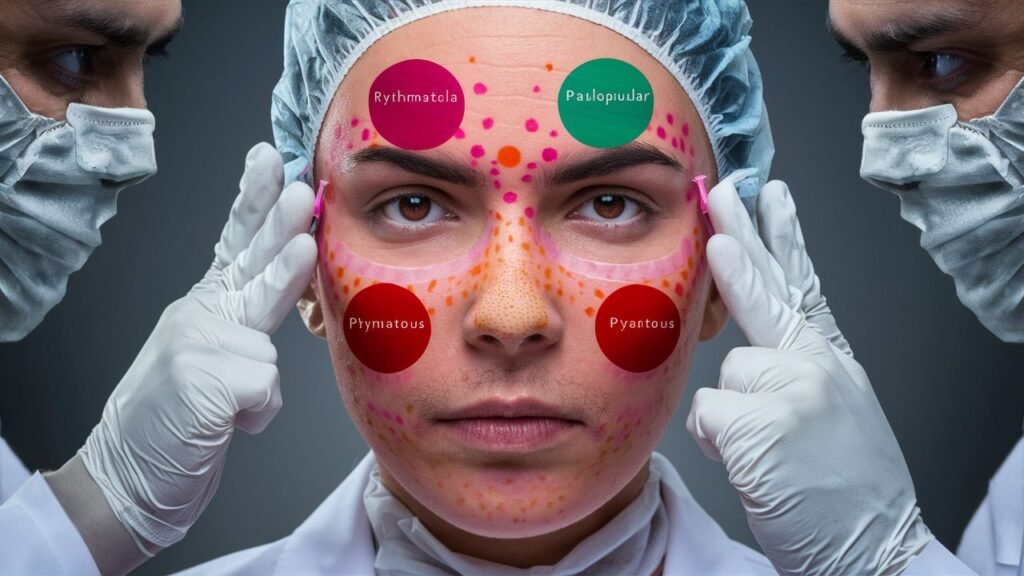
Common Subtypes of Rosacea
Rosacea can be categorized into several subtypes, including:
- Erythematotelangiectatic Rosacea: Characterized by persistent facial redness, visible blood vessels, and flushing.
- Papulopustular Rosacea: Marked by acne-like breakouts, redness, and inflammation.
- Phymatous Rosacea: Involves thickening of the skin, particularly on the nose (rhinophyma).
- Ocular Rosacea: Affects the eyes, causing redness, dryness, itching, and sensitivity.
Each subtype has unique symptoms and may require specific treatment approaches. Proper diagnosis by a healthcare professional is essential to determine the subtype and develop an appropriate treatment plan.
Treatments and Medications for Rosacea Subtypes
The treatment of rosacea is typically tailored to the subtype of the condition. Here are some common treatment options:
| Treatment | Erythematotelangiectatic Rosacea | Papulopustular Rosacea | Phymatous Rosacea | Ocular Rosacea |
|---|---|---|---|---|
| Topical Medications | Topical creams and gels to reduce redness and inflammation. | Topical antibiotics and anti-inflammatory creams to address acne-like breakouts. | Topical medications to minimize thickening of the skin. | Eye drops and ointments to relieve symptoms and manage eye-related complications. |
| Oral Medications | Oral antibiotics to control inflammation and redness. | Oral antibiotics for more severe inflammatory lesions. | Oral isotretinoin to treat severe thickening of the skin. | Oral antibiotics or anti-inflammatory drugs to manage ocular symptoms. |
| Laser and Light Therapies | Laser and light-based treatments to target facial redness and visible blood vessels. | Laser therapies to reduce redness and inflammation. | Laser treatments to reshape and improve the appearance of the affected skin. | Not applicable. |
It’s important to note that treatment plans may vary based on individual needs and preferences. Consulting with a dermatologist or healthcare professional is essential for accurate diagnosis and personalized treatment recommendations.
“Proper diagnosis of the specific subtype of rosacea is crucial for effective treatment and management.”
Reducing Rosacea Redness and Inflammation
One of the primary concerns for individuals with rosacea is reducing the redness and inflammation associated with this condition. Fortunately, there are various techniques and products specifically designed to soothe and calm the skin, minimizing the unsightly appearance of redness and inflammation.
When it comes to skincare products, look for ingredients that have proven efficacy in addressing rosacea symptoms. Some key ingredients to consider are:
- Aloe Vera: Known for its soothing properties, aloe vera helps reduce redness while moisturizing and cooling the skin.
- Green Tea Extract: Rich in antioxidants, green tea extract has anti-inflammatory effects and can help alleviate redness and inflammation.
- Niacinamide: This vitamin B3 derivative has been shown to strengthen the skin barrier and reduce redness and inflammation associated with rosacea.
- Chamomile: Chamomile possesses anti-inflammatory properties that can help calm and soothe red, irritated skin.
In addition to using skincare products with these beneficial ingredients, there are other techniques that can help minimize redness and inflammation:
- Apply cool compresses to the affected areas to reduce heat and soothe the skin.
- Avoid using harsh cleansers or abrasive exfoliants that can further irritate the skin.
- Protect your skin from excessive sun exposure by wearing sunscreen with a high SPF and seeking shade whenever possible. Sunburn can exacerbate rosacea symptoms.
- Manage stress levels through techniques such as meditation, deep breathing exercises, or engaging in activities that promote relaxation and well-being. Stress can trigger flare-ups and worsen redness and inflammation.
When incorporating new products or techniques into your skincare routine, it’s essential to patch test first and introduce them gradually to ensure compatibility with your skin. If you have any concerns or experience persistent redness and inflammation despite these measures, consult with a dermatologist for further evaluation and personalized treatment options.
Protecting and Nourishing Rosacea-Prone Skin
When it comes to managing rosacea, protecting your skin from external irritants and nourishing it with the right products are essential steps in your skincare routine. Follow these expert tips and recommendations to safeguard your skin and promote its overall health:
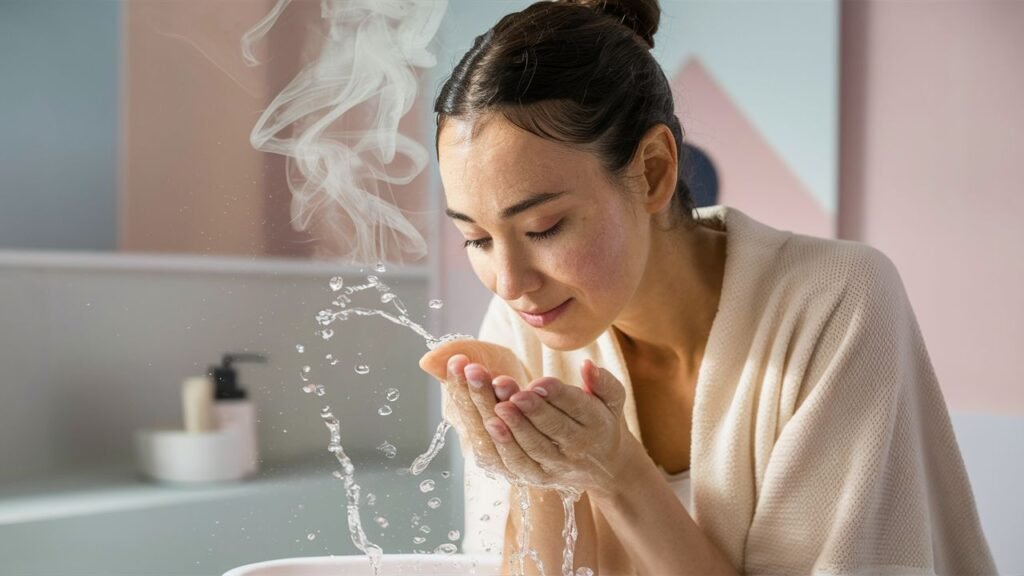
1. Use Sunscreen Daily
Apply a broad-spectrum sunscreen with an SPF of 30 or higher before going outdoors, even on cloudy days. Sun exposure can trigger rosacea flare-ups, so protecting your skin from harmful UV rays is crucial.
2. Avoid Harsh Ingredients
Avoid skincare products that contain alcohol, fragrances, and other harsh ingredients that can irritate your sensitive skin. Look for gentle, non-irritating formulations that are specifically designed for rosacea-prone skin.
3. Incorporate Gentle Skincare Products
Opt for gentle cleansers and moisturizers that are free of sulfates and other potentially irritating ingredients. Look for products that are labeled as “rosacea-friendly” or suitable for sensitive skin.
4. Hydrate Your Skin
Keep your skin hydrated by using a moisturizer daily. Look for moisturizers that are lightweight, non-comedogenic, and contain ingredients like hyaluronic acid or ceramides, which help to lock in moisture without clogging your pores.
5. Be Mindful of Temperature
Avoid hot water when cleansing your face or taking showers, as it can further aggravate your rosacea. Use lukewarm water instead to minimize skin irritation.
“Protecting and nourishing your skin is crucial for managing rosacea. By using sunscreen, avoiding harsh ingredients, and incorporating gentle skincare products, you can promote overall skin health and reduce the risk of flare-ups.”
6. Seek Professional Advice
If you’re unsure about which products or ingredients are suitable for your rosacea-prone skin, consider consulting a dermatologist. They can provide personalized recommendations and guidance based on your specific needs.
| Sunscreen | Gentle Skincare Products | Moisturizers |
|---|---|---|
| Bioderma Sensibio | Avene Antirougeurs | Cetaphil Daily Hydrating Lotion |
| La Roche-Posay Anthelios | Paula’s Choice CALM Redness Relief | Neutrogena Hydro Boost |
| EltaMD UV Clear | Dr. Jart+ Cicapair Tiger Grass Cream | CeraVe Daily Moisturizing Lotion |
Remember, everyone’s skin is different, so it’s important to find the right products that work well for you. Experiment with different brands and formulations to determine what is most beneficial for your individual needs.
Long-Term Management and Prevention Strategies for Rosacea
Managing rosacea is an ongoing process that requires a comprehensive approach to prevent flare-ups and maintain healthy skin. By implementing long-term strategies, individuals can keep rosacea under control and reduce the frequency and severity of symptoms. Here are some effective lifestyle modifications, skincare practices, and treatment maintenance tips to consider:
Lifestyle Modifications
- Avoid triggers: Identify and avoid common triggers that worsen rosacea symptoms, such as spicy foods, alcohol, sunlight, and stress.
- Protect your skin: Wear broad-spectrum sunscreen with an SPF of 30 or higher every day, even during cloudy days. Opt for physical sunscreens containing zinc oxide or titanium dioxide.
- Manage stress: Practice stress-reducing techniques, such as deep breathing exercises, meditation, yoga, and regular physical activity.
Skincare Practices
- Gentle cleansing: Cleanse your face with a mild, non-irritating cleanser twice a day. Avoid scrubbing or using harsh exfoliants that can aggravate rosacea.
- Moisturize daily: Use a fragrance-free, non-comedogenic moisturizer to keep your skin hydrated and prevent dryness and irritation.
- Choose rosacea-friendly products: Opt for skincare products labeled as suitable for sensitive or rosacea-prone skin. Avoid harsh ingredients, such as alcohol, fragrance, and synthetic dyes.
Treatment Maintenance Tips
- Follow prescribed medications: If your healthcare professional has prescribed medications for rosacea, ensure you take them as directed and complete the full course of treatment.
- Regular check-ups: Schedule regular follow-up visits with your dermatologist to monitor your progress, discuss any concerns, and adjust treatment if necessary.
- Consider maintenance therapy: Depending on the severity and type of rosacea, your dermatologist may recommend maintenance therapy to keep symptoms under control in the long term.
By implementing these long-term strategies, individuals can effectively manage rosacea and enjoy healthier, clearer skin. It’s important to consult with a healthcare professional for personalized advice and guidance based on your specific condition and needs.
Seeking Professional Help for Rosacea
While self-care and home remedies can be effective, it’s essential to consult with a healthcare professional for a comprehensive approach to managing rosacea. Professionals such as dermatologists can provide tailored treatment plans while specialists can offer guidance on lifestyle modifications.
When it comes to rosacea, each individual’s experience and symptoms may vary. Seeking professional help ensures that you receive personalized care and the most appropriate treatment options for your specific needs. Dermatologists are specialized in diagnosing and treating skin conditions, including rosacea. They can evaluate your symptoms, identify triggers, and provide effective treatment plans to address your concerns.
“Consulting a healthcare professional allows you to receive personalized care and the most appropriate treatment options for your specific needs.”
For severe cases of rosacea, prescription medications may be recommended by your healthcare professional. These medications can help reduce inflammation, control flare-ups, and minimize the visible signs of rosacea. Additionally, specialists such as ophthalmologists can provide guidance if your eyes are affected by ocular rosacea, a subtype that affects the eyes.
Here is a table with some of the best rated products to treat rosacea from iHerb and Amazon, including the name, description, price, and rating:
| Platform | Product Name | Description | Price | Rating |
|---|---|---|---|---|
| iHerb | Reviva Labs Rosacea Cream | Helps reduce redness, flushing, and visible blood vessels associated with rosacea. Contains natural ingredients like green tea, licorice, and aloe vera. | $12.99 | 4.5 out of 5 stars |
| iHerb | Era Organics Rosacea Relief Cream | Formulated with soothing botanical ingredients like colloidal oatmeal, green tea, and chamomile to calm redness and irritation. Paraben-free and non-comedogenic. | $19.97 | 4.7 out of 5 stars |
| Amazon | CeraVe Rosacea Facial Moisturizer | Lightweight, non-irritating moisturizer with ceramides, niacinamide, and licorice root extract to help calm redness and soothe sensitive skin. Fragrance-free and non-comedogenic. | $15.99 | 4.6 out of 5 stars |
| Amazon | La Roche-Posay Rosaliac AR Intense | Serum-based treatment with Pro-Vitamin B5 and La Roche-Posay Thermal Spring Water to reduce redness and visible capillaries associated with rosacea. Fragrance-free and non-comedogenic. | $39.99 | 4.5 out of 5 stars |
Please note that product availability, prices, and ratings may have changed since this information was compiled in August 2023. It’s always a good idea to consult with a healthcare professional before starting any new treatment for rosacea.
Importance of a Healthcare Professional:
“A healthcare professional can accurately diagnose rosacea and provide personalized treatment plans.”
“They can offer expertise in managing rosacea symptoms and provide guidance on lifestyle modifications.”
“Prescription medications may be necessary for severe cases of rosacea.”
Remember, managing rosacea requires a comprehensive approach that addresses both the visible symptoms and underlying triggers. Seeking professional help ensures that you have access to the most effective treatment options and ongoing support to manage your condition.
Next, we’ll explore the importance of recognizing and treating the different subtypes of rosacea, as well as techniques to reduce redness and inflammation.
Conclusion
In conclusion, effectively healing and concealing rosacea requires a comprehensive approach that combines skincare routines, treatment options, lifestyle changes, and self-care practices. By gaining a deep understanding of the causes, triggers, and symptoms of rosacea, individuals can develop personalized strategies to manage and control this chronic condition, resulting in relief and improved skin health.
Creating a rosacea-friendly skincare routine is essential for managing symptoms and promoting healing. Gentle cleansers, moisturizers, and SPF products specifically designed for rosacea-prone skin can help minimize irritation and inflammation. Additionally, identifying and avoiding common triggers like sunlight, alcohol, and spicy foods can significantly reduce the frequency and intensity of flare-ups.
For those seeking additional support, professional help from dermatologists and specialists can provide tailored treatment plans and lifestyle recommendations. By incorporating stress management techniques and adopting a balanced diet, individuals can further contribute to the natural healing process of their skin.
With proper care and dedication, individuals can effectively manage rosacea and improve their overall quality of life. It’s important to remember that everyone’s skin is unique, so finding the most suitable combination of skincare products and treatment methods may require some experimentation. By staying informed and proactive, individuals can take control of their rosacea and achieve healthier, more radiant skin.
FAQ
What is rosacea?
Rosacea is a chronic skin condition that primarily affects the face. It is characterized by persistent redness, visible blood vessels, and sometimes small bumps and pustules.
What causes rosacea?
The exact cause of rosacea is still unknown, but it is believed to be a combination of genetic and environmental factors. Common triggers include sun exposure, hot beverages, spicy foods, alcohol, and stress.
What are the common symptoms of rosacea?
Common symptoms of rosacea include persistent redness, flushing, visible blood vessels, swollen bumps, and eye irritation. These symptoms can vary in severity and may come and go in cycles.
How can I manage rosacea flare-ups?
Managing rosacea flare-ups involves identifying and avoiding triggers, developing a gentle skincare routine, protecting the skin from the sun, and managing stress levels. It is also important to seek professional advice and treatment.
What skincare products should I use for rosacea?
When managing rosacea, it’s best to use gentle, non-irritating skincare products. Look for products labeled “suitable for sensitive skin” or “rosacea-friendly.” Avoid harsh ingredients like alcohol, fragrances, and abrasive exfoliants.
Are there any effective treatments for rosacea?
Yes, there are various treatment options available for rosacea. These include topical creams, oral medications, laser therapy, and natural remedies. Consult with a dermatologist to determine the most suitable treatment approach for your specific case.
Can makeup help conceal rosacea?
Yes, makeup can help conceal rosacea and reduce the appearance of redness. Look for makeup products specifically formulated for sensitive skin, and use techniques such as color correction and layering to achieve a natural-looking finish.
Are there any natural remedies for rosacea?
There are some natural remedies that may provide relief for rosacea symptoms, such as green tea, aloe vera, and chamomile. However, it’s important to consult with a healthcare professional before trying any natural remedies to ensure they are safe and suitable for your condition.
How can I prevent rosacea flare-ups?
Preventing rosacea flare-ups involves identifying and avoiding triggers, protecting the skin from the sun, managing stress levels, and following a gentle skincare routine. It’s also important to establish a healthy lifestyle and avoid factors known to worsen rosacea symptoms.
When should I seek professional help for rosacea?
It is recommended to seek professional help for rosacea if your symptoms are severe, impacting your quality of life, or if over-the-counter treatments are not providing relief. A dermatologist can provide a comprehensive treatment plan tailored to your specific needs.


